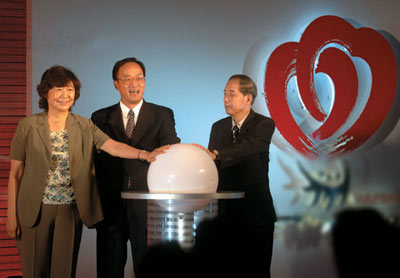 |
 |
 |
 |
 |
| The Road to the Olympics | |
|
Since 1949, China has participated in six summer and eight winter Olympics, winning 112 gold medals in summer Olympics. At the Los Angeles, Barcelona and Atlanta Olympics, China came fourth in the gold medals table, and second at the Athens Olympics. In 1979 China resumed its legitimate membership of the International Olympic Committee (IOC). In 1981 He Zhenliang was elected an IOC member, marking a new period in the relations between China and the Olympics and cooperation with the IOC. From then on, Chinese sports circles started to popularize and promote the Olympics. An important part of their work was to have the Chinese people, representing one fifth of the world's population, share the honor and joy of hosting the Olympic Games, thus reflecting the Olympic principle of inclusivity. In July 2001, Beijing finally succeeded in its bid to bring the 2008 Olympic Games to its ancient capital with a history of 3,000 years. The Beijing Olympic Organizing Committee (BOOC), established at the end of 2001, set the themes for the 2008 Games as "Green Olympics," "High-tech Olympics" and "Humanistic Olympics." Since 2003, after the whole 2008 Olympics program was settled and made known, and following a fair bidding process for their design and construction, 30 Olympic venues have been started and will be built by the end of 2007. Seven venues, including the National Stadium and the National Swimming Center, are of exquisite and ingenious design, ushering in a new period of poetic architecture for Beijing. The centerpiece of the 2008 Games will be "the Bird's Nest" National Stadium. With a capacity of 100,000 spectators, the stadium will host the opening and closing ceremonies as well as track-and-field events. In constructing the National Swimming Center — "the Water Cube" a membrane structure made of advanced material called ETFE (ethylene-tetra-fluoro-ethylene) has been adopted for the first time. In responding to the functional demands of the building, the result will be the world's most complex system and largest built area of membrane structure. In addition, Beijing will spend 180 billion yuan on infrastructure construction, much of the expenditure devoted to 142 large-scale projects including high-speed transportation networks, environmental improvements and creation of information systems.
Start of volunteer recruitment for the 2008 Beijing Olympics and Paralympics, August 28, 2006 |
| Copyright © China.org.cn. All Rights Reserved E-mail: webmaster@china.org.cn |
